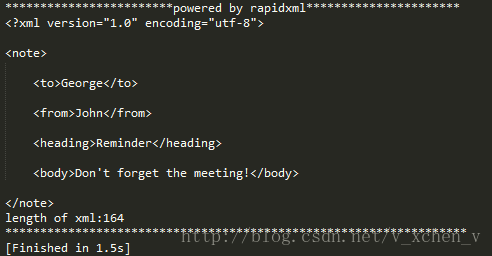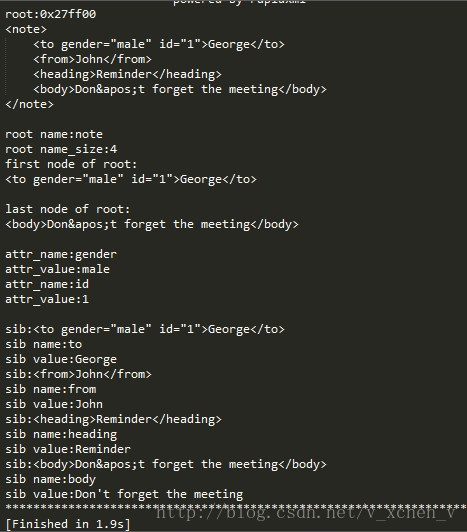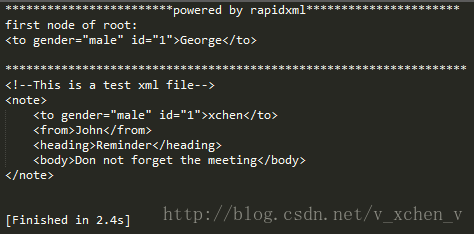c++开源库rapidxml介绍与示例
官方地址:http://rapidxml.sourceforge.net/
官方手册:http://rapidxml.sourceforge.net/manual.html
也可以在github上下载到别人上传的rapidxml:https://github.com/dwd/rapidxml
1.头文件
一般我们用到的头文件只有这三个
#include "rapidxml/rapidxml.hpp"
#include "rapidxml/rapidxml_utils.hpp" //rapidxml::file
#include "rapidxml/rapidxml_print.hpp" //rapidxml::print
2.常用方法:
1)加载一个XML文件的内容
方法:rapidxml::file<> valName(“filepath”);
定义:rapildxml_print_utils.hpp,这个头文件中定义了file类,这个类有两个成员函数data()和size()分别返回char*的xml文本内容和unsigned int型的文本数据长度
示例:
#include "rapidxml/rapidxml.hpp"
#include "rapidxml/rapidxml_utils.hpp" //rapidxml::file
#include "rapidxml/rapidxml_print.hpp" //rapidxml::print
#include
// using namespace std;
int main(int argc, char const *argv[])
{
//读取xml
rapidxml::file<> fdoc("test.xml");
std::cout<<"************************powered by rapidxml**********************"< 2)加载DOM tree
类:xml_document
定义一个该类的对象doc
rapidxml::xml_document<> doc;
类的定义位置:rapidxml.hpp
类的成员函数:
1)parse(Ch *text) 将数据解析为DOM Tree
使用时doc.parse(text);
parseFlag指定格式,可以用’|’来组合使用
常用的parseFlag:
parseFlag为0表示默认的parseflag
parse_comment_nodes表示带上xml中的注释
parse_no_data_nodes在要修改结点值的时候要设置这个parseFlag
2) clear() 清空DOM Tree
此外xml_document继承自xml_node因此还具有xml_node的方法。
示例:
#include "rapidxml/rapidxml.hpp"
#include "rapidxml/rapidxml_utils.hpp" //rapidxml::file
#include "rapidxml/rapidxml_print.hpp" //rapidxml::print
#include
// using namespace std;
int main(int argc, char const *argv[])
{
//读取xml
rapidxml::file<> fdoc("test.xml");
std::cout<<"************************powered by rapidxml**********************"< doc;// character type defaults to char
doc.parse<0>(fdoc.data());// 0 means default parse flags
std::cout<<"#1"< 3)获取DOM Tree结点
rapidxml::xml_node<> *root;
类:xml_node
定义一个该类的对象root
定义于:rapidxml.hpp
常用的类成员函数:
1)node_type type() const; 获取结点类型 获取的类型是枚举的
2)Ch* name() const; 获取结点名
3)std::size_t name_size() const; 获取结点名长度
4)Ch* value() const; 获取结点值
5)std::size_t value_size() const; 获取结点值长度
6)xml_node* first_node(const Ch *name=0, std::size_t name_size=0, bool case_sensitive=true) const; 获取DOM Tree第一个子结点的指针
第一个参数为节点名,如果给定第一个参数为”a”,则该函数寻找结点名为a的第一个子结点;第二个参数为结点名长度
7)xml_node* last_node(const Ch *name=0, std::size_t name_size=0, bool case_sensitive=true) const; 获取DOM Tree最后一个子结点的指针
参数含义同上
8)xml_attribute* first_attribute(const Ch *name=0, std::size_t name_size=0, bool case_sensitive=true) const; 获取结点的第一个属性指针
9)xml_attribute* next_attribute(const Ch *name=0, std::size_t name_size=0, bool case_sensitive=true) const; 获取结点的下一个属性指针
10)xml_attribute* last_attribute(const Ch *name=0, std::size_t name_size=0, bool case_sensitive=true) const;获取结点的最后一个属性指针
属性指针的格式见类xml_attribute
11)xml_node* previous_sibling(const Ch *name=0, std::size_t name_size=0, bool case_sensitive=true) const;获取上一个同级结点的指针
12)xml_node* next_sibling(const Ch *name=0, std::size_t name_size=0, bool case_sensitive=true) const; 获取下一个同级结点的指针
13)xml_attribute* first_attribute(const Ch *name=0, std::size_t name_size=0, bool case_sensitive=true) const; 获取第一个同级结点的指针
14)xml_attribute* last_attribute(const Ch *name=0, std::size_t name_size=0, bool case_sensitive=true) const; 获取最后一个同级结点的指针
15)void insert_node(xml_node< Ch > *where, xml_node< Ch > *child);在第一个参数指向的结点之前,插入一个结点
示例:
test.xml
George
John
Reminder
Don't forget the meeting
cpp
#include "rapidxml/rapidxml.hpp"
#include "rapidxml/rapidxml_utils.hpp" //rapidxml::file
#include "rapidxml/rapidxml_print.hpp" //rapidxml::print
#include
using namespace std;
int main(int argc, char const *argv[])
{
//读取xml
rapidxml::file<> fdoc("test.xml");
cout<<"************************powered by rapidxml**********************"< doc;// character type defaults to char
doc.parse<0>(fdoc.data());// 0 means default parse flags
//DOM Tree的第一个子结点就是根结点
rapidxml::xml_node<> *root = doc.first_node();
cout<<"root:"<name()<name_size()< *node_first = root->first_node();
cout<<"first node of root:"< *node_last = root->last_node();
cout<<"last node of root:"<first_node("to");
rapidxml::xml_attribute<> *attr;
attr = node_first->first_attribute();
cout<<"attr_name:"<name()<value()<next_attribute();
cout<<"attr_name:"<name()<value()<next_sibling())
{
cout<<"sib:"<<*node_first;
cout<<"sib name:"<name()<value()< *node_last = doc.last_node();
// std::cout< 4.获取属性
类:xml_attribute
定义于:rapidxml.hpp
常用方法:
1)xml_attribute *previous_attribute(const Ch *name = 0, std::size_t name_size = 0, bool case_sensitive = true) const;获取前一个属性
2)xml_attribute *next_attribute(const Ch *name = 0, std::size_t name_size = 0, bool case_sensitive = true) const;获取后一个属性
5.输出
1)操作符<<
示例:
#include "rapidxml/rapidxml.hpp"
#include "rapidxml/rapidxml_utils.hpp" //rapidxml::file
#include "rapidxml/rapidxml_print.hpp" //rapidxml::print
#include
using namespace std;
int main(int argc, char const *argv[])
{
//读取xml
rapidxml::file<> fdoc("test.xml");
cout<<"************************powered by rapidxml**********************"< doc; // character type defaults to char
doc.parse(fdoc.data()); // 0 means default parse flags
//DOM Tree的第一个子结点就是根结点
rapidxml::xml_node<> *root = doc.first_node("note");
rapidxml::xml_node<> *node_first = root->first_node();
cout<<"first node of root:"<value("xchen");
cout<<"******************************************************************"< 6.为一个新的属性或者结点分配空间
1)为结点分配空间
xml_node* allocate_node(node_type type, const Ch *name=0, const Ch *value=0, std::size_t name_size=0, std::size_t value_size=0);
2)为属性分配空间
xml_attribute* allocate_attribute(const Ch *name=0, const Ch *value=0, std::size_t name_size=0, std::size_t value_size=0);




